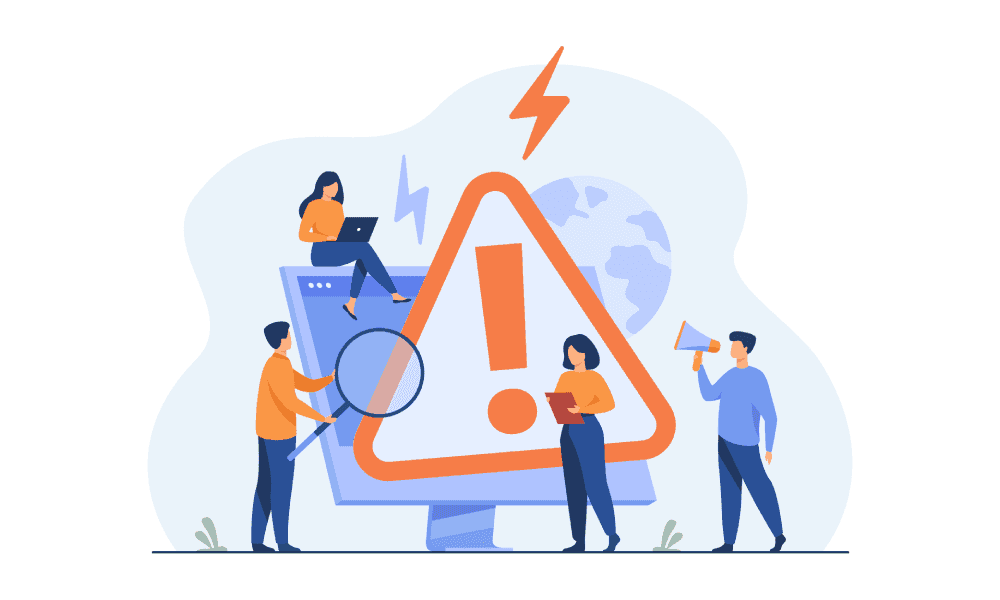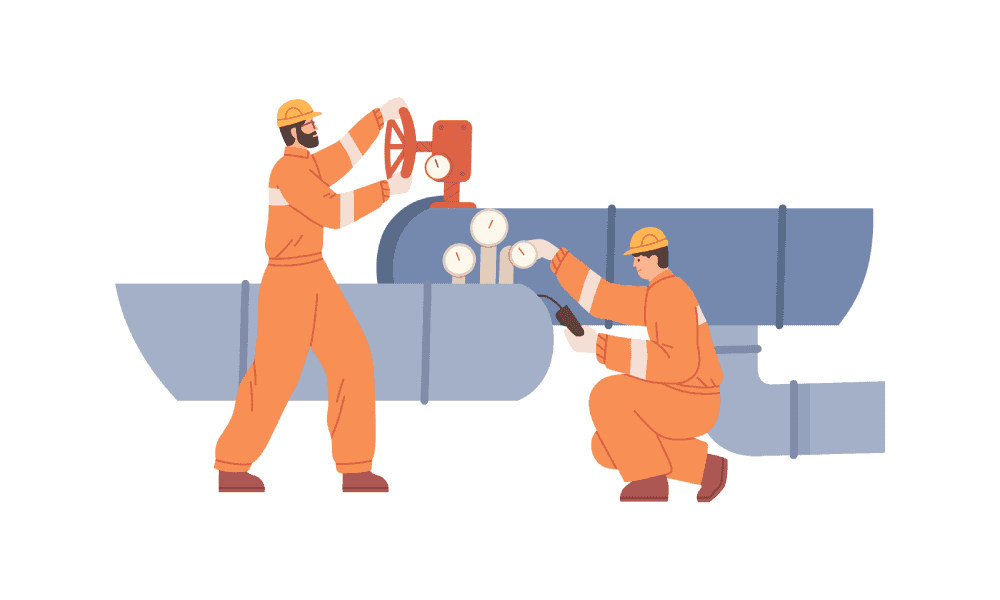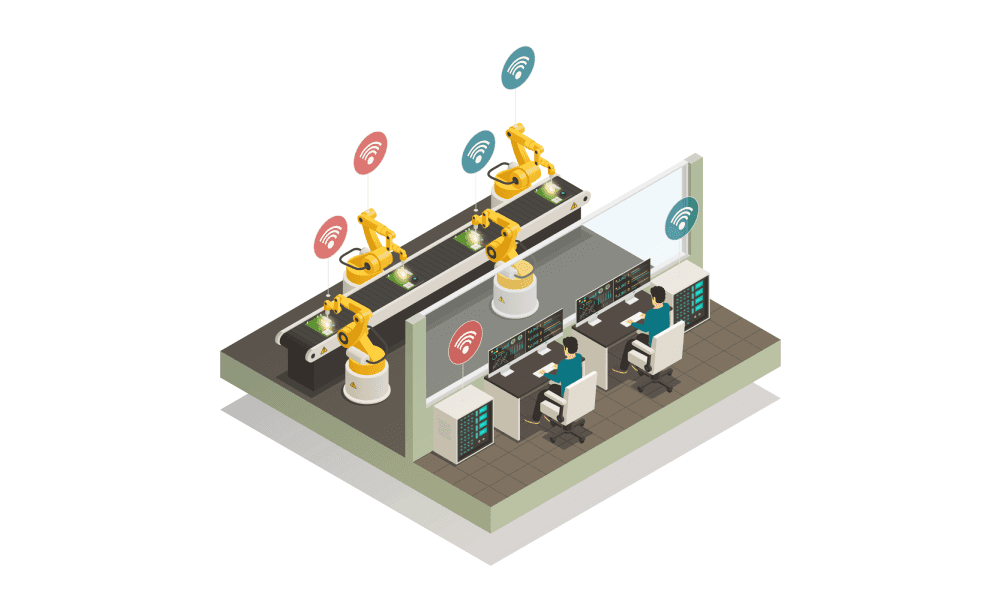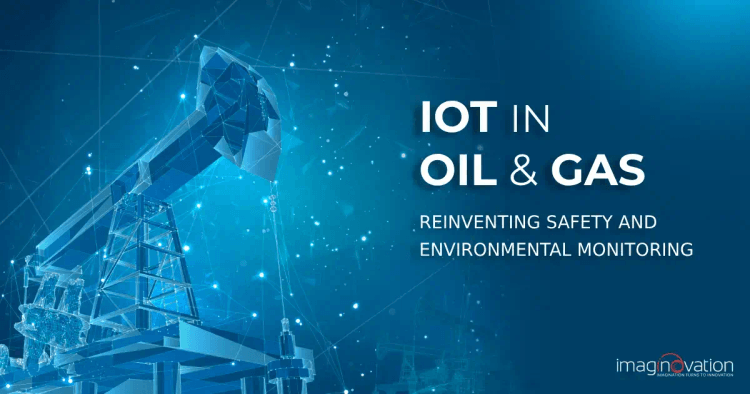Innovation is the key to growth in any industry. It brings simplification and a completely new experience to the people willing to accept the change and make the most out of it.
In Oil and Gas industry, the Internet of Things (IoT) is one such innovation that is changing how safety and environmental monitoring works.
With IoT, the industry can say goodbye to disconnected operations and embrace digitization, optimization, and automation like never before.
IoT solutions make real-time monitoring of your remote assets (pipelines, power plants, etc.) a reality, ensuring that potential risks are detected promptly. Not only that, but predictive maintenance takes center stage, allowing you to schedule repairs before breakdowns occur, saving both time and money.
And the best part… Remote operations become safer and more efficient as IoT enables monitoring and control from a distance.
In this blog, let us explore the key benefits IoT offers and some fascinating applications of IoT in the oil and gas industry.
Let’s begin!
Key Benefits of IoT in Oil and Gas
IoT establishes a network of interconnected devices and sensors that gather, analyze, and exchange data in real-time.
With its ability to connect devices and sensors to the internet, IoT offers a range of benefits that enhance operations, safety, and efficiency within the oil and gas industry.
Here are the key benefits of IoT in oil and gas:
1. Real-time tracking and visibility
IoT solutions also enhance real-time monitoring in oil and gas companies like yours by enabling continuous tracking and monitoring of critical assets and operations.
For instance, IoT sensors can be deployed on drilling equipment, pipelines, and storage tanks in offshore oil drilling. These sensors collect and transmit data on parameters such as temperature, pressure, flow rates, and equipment performance.
The real-time data related to different parameters is then analyzed and sent to operators. It gives them instant insights into the status of essential assets. If any safety concerns are detected, immediate alerts are sent to the relevant personnel for timely intervention.
For example, if a sensor detects a sudden rise in temperature or pressure in a pipeline, the IoT system can immediately trigger an alert to the control room. In such a case, operators can quickly assess the situation, shut down the affected section, and take necessary actions to prevent a potential equipment failure.
2. Hazards management

Oil and gas companies can use IoT technology to closely monitor dangerous situations, such as flammable gases and toxic vapors in the air.
For example, you can monitor hazardous environments in real-time with IoT-enabled sensors. The sensors immediately send alerts if something unusual happens, like a gas leak, oil spill, or equipment malfunction.
This allows you to take quick action and prevent accidents, thus protecting the safety of your workers and environment.
Hazard management thus becomes a crucial part of IoT adoption in the oil and gas industry, ensuring a proactive approach to risk mitigation.
3. Lessened environmental impact
The oil and gas sector significantly contributes to climate change. It is responsible for more than 40 percent of global greenhouse gas emissions.
To lower their environmental impact, companies in the industry can use IoT for leak detection and predictive maintenance to minimize emissions and flaring. Additionally, IoT can be employed by downstream operators to enhance energy efficiency.
4. Process automation
IoT lets you analyze important factors such as pipe thickness, flow rate, and pressure in real-time.
Instead of relying on manual labor, IoT-enabled smart devices can provide accurate measurements.
By leveraging the power of big data and IoT sensors, you can automate processes and enhance efficiency in your refinery.
Monitoring becomes simpler and more convenient because employees only need to intervene in rare cases of external errors. Otherwise, the entire process is automated, ensuring optimal outcomes.
5. Predictive maintenance
IoT sensors installed at oil and gas facilities provide valuable data.
This data can be used for predictive analytics, which helps us identify potential issues before they become big problems.
Such a proactive approach also prevents long and unplanned downtimes and ensures smooth operations while efficiently using your assets.
For example, it gives you the power of asset inspection and accurate insights into day-to-day operations. This way, you'd know in advance when maintenance is needed and address the issues before any breakdown occurs.
This capability is particularly beneficial for maintaining remote offshore facilities, where visibility is limited and manual check-ups are relied upon.
6. Remote monitoring

In upstream oil and gas production, field workers must continuously monitor equipment and parameters to maximize efficiency.
Implementing remote site monitoring through IoT allows maintenance teams to be less reactive and address issues proactively.
This approach ensures the safety of workers by reducing their exposure to potentially hazardous work environments.
7. Workforce productivity
Another area where IoT is handy in the oil and gas industry is workforce productivity. IoT brings field workers and office locations together while enhancing productivity.
By installing IoT devices like sensors, drones, and robots, we can eliminate the need for on-site employees. Employees can work on other essential processes.
With IoT technology, oilfield workers can stay connected and work more efficiently. This interconnectedness helps bridge communication gaps, improving safety measures and increasing workforce productivity.
By harnessing the potential of IoT, the oil and gas industry creates a collaborative environment and ensures the well-being of its workforce.
8. Regulatory compliance
By embracing IoT in your oil and gas company, you can significantly enhance regulatory compliance throughout your operations.
IoT’s ability of predictive maintenance helps you keep your equipment in optimal condition and ensures compliance with safety standards.
You can proactively prevent non-compliance due to equipment malfunctions.
Moreover, since IoT devices generate vast amounts of data that can be analyzed using advanced analytics, you can identify compliance-related patterns, trends, and anomalies. You can then take proactive actions to address potential compliance issues.
IoT Applications in Safety Monitoring
IoT in oil and gas plays a crucial role in safety monitoring. By leveraging IoT technology, you can enhance safety protocols, mitigate risks, and protect the well-being of your workers and the environment.
Let’s find out how:
Gas leak detection

By utilizing IoT in gas, we can enhance their safety measures, for example, in the case of gas leak detection.
IoT-enabled gas leak detection systems consist of sensors that continuously monitor gas levels, pressure, and temperature and detect any leaks.
You can deploy these sensors throughout the gas facility, including pipelines, storage tanks, and processing units.
If a gas leak is detected, the IoT solution sends immediate alerts to the concerned personnel, allowing them to take prompt action and mitigate the risk.
This real-time monitoring capability helps to minimize the time it takes to identify and address leaks and ensure the safety of workers and the surrounding environment.
Emission monitoring and control
IoT plays a crucial role in emission monitoring and control in the energy sector.
With the help of IoT technology, you can effectively track, analyze, and manage emissions and comply with environmental regulations.
You can continuously monitor emission levels by deploying IoT-enabled sensors at different points in the production and refining processes. These sensors measure essential parameters such as particulate matter (PM), greenhouse gases, volatile organic compounds (VOCs), and other pollutants.
This data is then transmitted in real-time to a central monitoring system.
Based on the findings of this real-time data, you can take immediate actions to control emissions and ensure they stay within the limits set by regulations.
You can also adjust your processes if needed.
Remote monitoring of equipment and infrastructure
Oil & gas sites are usually present in remote locations. IoT-enabled smart sensors are specifically helpful in these remote locations to monitor and control operations.
These solutions closely monitor equipment performance and environmental conditions and even detect abnormalities in real-time.
With IoT, oil and gas companies can be available round the clock to handle various issues, from spills to emergency shutdowns and unplanned equipment downtime to other remote field operations.
IoT sensors also bring another advantage here, predictive maintenance, which presents a smart way of maintenance.
With the help of data collected from IoT sensors, you can know when equipment is likely to fail. This valuable information allows you to schedule maintenance proactively, preventing unexpected breakdowns and the need for emergency repairs.
As a result, you not only save money and avoid costly repairs, but you also extend the lifespan of your equipment.
Enhanced workers safety

As per Statista, In 2019 alone, there were 127 deaths in mining, quarrying, oil, and gas extraction industries, with 104 occurring in the oil and gas extraction sector.
One of the primary reasons why the oil and gas industry is adopting IoT technology is to prioritize safety and reduce the risk of accidents.
By installing IoT devices, there's no need for employees to be physically present in hazardous conditions to ensure everything is running smoothly. Instead, they can work remotely and monitor operations that can be automated now.
Because of a real-time tracking facility with IoTs, immediate actions can be triggered to protect workers and prevent disasters if there's an emergency.
IoT adoption is thus revolutionizing the industry by keeping workers out of harm's way.
IoT Applications in Environmental Monitoring
IoT in energy is changing how the industry takes care of the environment and moving towards a greener and more sustainable future.
Let’s take a look.
Air quality monitoring
Various organic compounds such as carbon monoxide, hydrocarbons, and chemicals, commonly known as "greenhouse gases," are released into the air during industrial processes. Additionally, emissions from vehicles also contribute to air pollution.
With IoT technology, you can build a smart sensor network that continuously measures air quality parameters, including particulate matter, carbon monoxide, nitrogen dioxide, and more.
These sensors are strategically placed in various locations to ensure comprehensive coverage and accurate air quality monitoring. The collected data is analyzed and interpreted.
The insights gained from this data can give you a clear understanding of the air quality levels and identify any pollutants present in the environment.
Water and soil monitoring
IoT facilitates real-time analysis of water quality parameters like pH levels, dissolved oxygen, turbidity, and temperature.
In this case, IoT-based sensors are deployed in various water bodies, including rivers, lakes, and reservoirs. These sensors continuously assess water quality indicators and transmit the data to a centralized system.
In case of contamination or water quality changes, prompt detection leads to timely actions.
Similarly, IoT sensors can measure soil moisture, temperature, and nutrient levels in soil monitoring.
IoT Applications in Refining and Processing
With IoT, you can endeavor to control the production process from a distance, thus reducing the need for physical labor.
As IoT devices and sensors gather more data, the algorithm becomes smarter, improving production efficiency and reducing the chances of human mistakes.
Let’s explore some exciting applications of IoT in refining and processing.
Process optimization and control

Real-time monitoring of process variables - IoT enables operators to monitor temperature, pressure, and flow rates in real-time, allowing them to quickly identify discrepancies and make necessary adjustments. This improves process efficiency and productivity.
Easy decision-making with advanced analytics - IoT platforms use advanced analytics to analyze data collected from sensors and devices. This helps operators make data-driven decisions. By identifying trends and patterns, operators can optimize processes, reduce waste, and improve overall performance, achieving significant returns on investment within a short period of time.
Equipment monitoring
Bringing down equipment downtime & maintenance costs - IoT applications in refining and processing provide real-time monitoring of equipment performance, detecting issues early on to prevent costly downtime and minimize maintenance expenses.
Extending equipment lifespan - IoT-enabled predictive maintenance helps operators understand equipment wear and tear, allowing for timely maintenance and optimal equipment usage. This proactive approach reduces the risk of equipment failure and extends its lifespan, thus maximizing return on investment.
Generating digital twins - IoT-based digital twin technology is used to investigate problems, identify their root causes, and develop solutions. It enhances asset management and productivity, enabling performance analysis and asset comparison.
Challenges of IoT Adoption in the Oil and Gas Industry
When it comes to streamlining operations in various business systems, IoT undeniably takes center stage.
It revolutionizes various business processes in the oil and gas industry. However, implementing IoT solutions in this industry has its fair share of challenges.
Let's explore some of these hurdles:
1. Establishing seamless connectivity
Oil and gas operations occur in remote areas, like offshore platforms or remote drilling sites. These locations often lack the robust network infrastructure needed for consistent IoT connectivity.
In addition, oil and gas facilities face harsh environmental conditions like extreme temperatures, high humidity, and corrosive substances. They can impact network equipment and connectivity reliability.
2. Data security and privacy issues

With IoT devices collecting and handling large amounts of sensitive data, there are substantial risks to data security and privacy. Managing and securing this large volume of data from numerous sources is complex, requiring robust systems and protocols.
Therefore, ensuring foolproof cybersecurity measures to address potential vulnerabilities in IoT networks is crucial.
3. Smooth integration
Integrating IoT systems with existing legacy infrastructure and software can be challenging.
Ensuring compatibility and seamless integration between new IoT solutions and existing systems is crucial to avoid disruptions and maximize the benefits of IoT adoption.
4. High initial investment
Implementing IoT solutions can be expensive, requiring significant investments in hardware, software, and infrastructure upgrades.
The high costs associated with IoT adoption may pose a financial challenge for companies operating in the oil and gas sector. Therefore, companies must assess the ROI and other long-term advantages before implementing them.
5. Workforce skills gap
Implementing IoT in energy requires a skilled workforce with broad expertise. However, there may be a shortage of professionals with the necessary expertise in IoT and the specific needs of the oil and gas industry.
With the rapid growth of the IoT market, the demand for such professionals is increasing. This can lead to higher project costs and difficulties in finding professionals with the required skills to complete a project successfully.
Leverage IoT for Improved Safety & Environment Monitoring With Imaginovation
Embracing IoT technology opens up possibilities for a safer and more sustainable tomorrow in the energy sector.
That's why the oil and gas industry has widely adopted IoT technologies to enhance workflows, improve safety, and increase productivity. IoT helps reduce manual maintenance, automate complex tasks, and minimize environmental hazards.
According to statistics, the global IoT adoption in the oil and gas market is projected to witness remarkable growth, with an increase from USD 11.34 billion in 2022 to USD 22.44 billion by 2029, reflecting a notable Compound Annual Growth Rate of 10.1 percent.
If you are looking for knowledgeable experts who can demystify IoT for your company and guide you toward the ideal IoT solution for your specific needs, contact us at Imaginovation.
We can help you unlock the potential of IoT to revolutionize safety and environmental monitoring.
Imaginovation is an award-winning web and mobile app development company with vast experience crafting remarkable digital success stories for diverse companies.
Let's talk.
Ready to build an app, but not sure where to start?
We've got you covered. Click the button below to get started.





